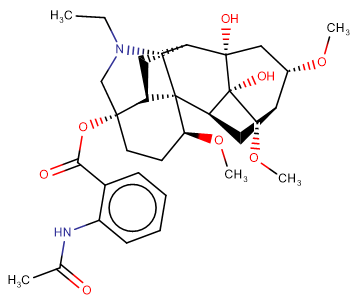
Lappaconitine
CAS No. 32854-75-4
Lappaconitine( Lappaconitine )
Catalog No. M14074 CAS No. 32854-75-4
Lappaconitine, isolated from Aconitum sinomontanum Nakai, was characterized as analgesic principle.
Purity : >98% (HPLC)
 COA
COA
 Datasheet
Datasheet
 HNMR
HNMR
 HPLC
HPLC
 MSDS
MSDS
 Handing Instructions
Handing Instructions
| Size | Price / USD | Stock | Quantity |
| 5MG | 36 | Get Quote |


|
| 10MG | 51 | Get Quote |


|
| 25MG | 85 | Get Quote |


|
| 50MG | 125 | Get Quote |


|
| 100MG | 178 | Get Quote |


|
| 200MG | 267 | Get Quote |


|
| 500MG | 462 | Get Quote |


|
| 1G | Get Quote | Get Quote |


|
Biological Information
-
Product NameLappaconitine
-
NoteResearch use only, not for human use.
-
Brief DescriptionLappaconitine, isolated from Aconitum sinomontanum Nakai, was characterized as analgesic principle.
-
DescriptionLappaconitine, isolated from Aconitum sinomontanum Nakai, was characterized as analgesic principle.
-
In Vitro——
-
In Vivo——
-
SynonymsLappaconitine
-
PathwayOthers
-
TargetOther Targets
-
RecptorOthers
-
Research AreaOther Indications
-
Indication——
Chemical Information
-
CAS Number32854-75-4
-
Formula Weight584.64
-
Molecular FormulaC32H44N2O8
-
Purity>98% (HPLC)
-
SolubilityDMSO: 10 mM
-
SMILESCCN1C[C@@]2(CC[C@H](OC)[C@@]34[C@@H]2C[C@@H]([C@@H]13)[C@@]5(O)C[C@H](OC)[C@H]6C[C@@H]4[C@]5(O)[C@H]6OC)OC(=O)c7ccccc7NC(=O)C
-
Chemical Name(3S,6S,6aS,7S,7aS,8S,9R,10S,11aS,12S,12aR,14S)-1-ethyl-7a,11a-dihydroxy-6,8,10-trimethoxydodecahydro-2H-3,6a,12-(epiethane[1,1,2]triyl)-7,9-methanonaphtho[2,3-b]azocin-3(4H)-yl 2-acetamidobenzoate
Shipping & Storage Information
-
Storage(-20℃)
-
ShippingWith Ice Pack
-
Stability≥ 2 years
Reference
1.Bryzgalov AO, et al. Cardiovasc Hematol Agents Med Chem. 2013 Sep;11(3):211-7.
molnova catalog



related products
-
(S)-3-(4-Hydroxyphen...
(S)-3-(4-Hydroxyphenyl)-2-hydroxypropionic acid (compound 1) is a metabolite isolated from the culture medium of Leuconostoc mesenteroides.
-
1-Oleoyl-rac-glycero...
1-O-Oleyl-rac-glycerol also known as monoolein is a surfactant that releases free glycerol and oleic acid upon hydrolysis.
-
Flecainide hydrochlo...
Flecainide is a medication used to prevent and treat abnormally fast heart rates.?This includes ventricular and supraventricular tachycardias.



 Cart
Cart
 sales@molnova.com
sales@molnova.com


